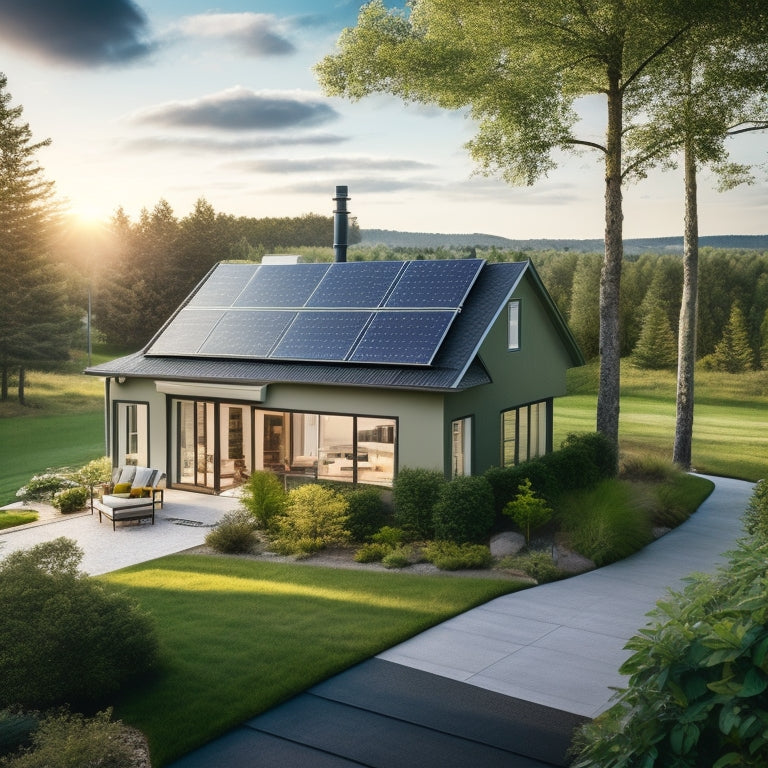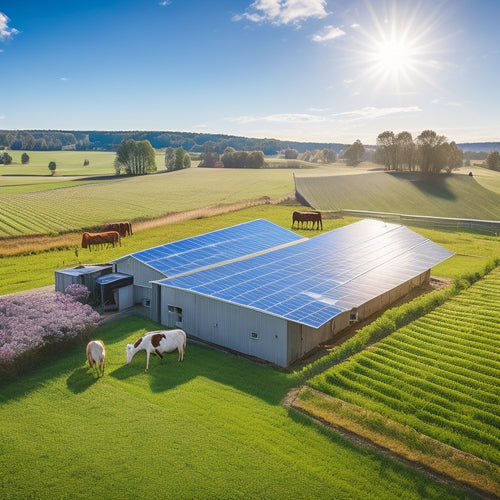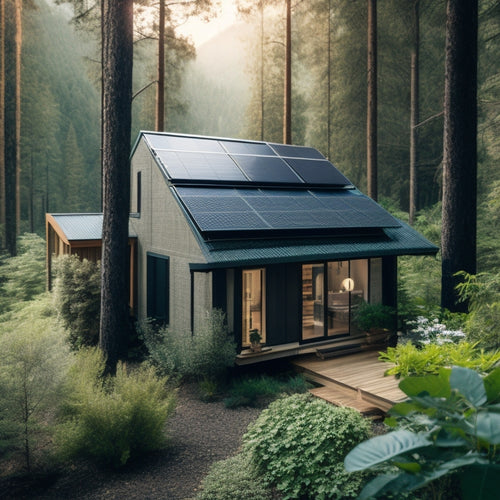
10 Best Large House Energy System Costs
Share
You're investing in a large house energy system, and upfront costs can range from $15,000 to over $100,000, depending on the system's size, components, and features. Solar panels, for instance, can cost between $15,000 and $30,000, with incentives like the Solar Investment Tax Credit reducing the burden. Energy storage systems, like the Tesla Powerwall, can add $7,000 to $15,000 to the total. Inverters, mounting options, and permits further impact the overall cost. Your specific needs, roof size, and location will influence the final figure. As you investigate your options, you'll realize how each component contributes to the total system cost, and how to optimize your investment.
Overview
- Large home solar panel prices range from $15,000 to $30,000, with incentives like the Solar Investment Tax Credit reducing upfront costs.
- System size and energy output vary, with a 10 kW system producing 40-50 kWh/day, and balancing output with consumption is crucial for maximizing ROI.
- Installation costs increase with larger roofs, and planning for permits and inspections is essential to avoid budget surprises, with total costs ranging from $30,000 to $100,000 or more.
- Energy storage systems, like Tesla Powerwall and LG Chem RESU, cost between $7,000 to $15,000, and battery backup systems ensure continuous power supply during outages.
- Financing options and energy incentives can alleviate upfront expenses, and careful planning and research are vital for successful project execution and long-term cost savings.
Large Home Solar Panel Prices
With large homes often boasting expansive rooftops, solar panels can be an attractive option for utilizing renewable energy.
You'll be pleased to know that the cost of solar panels has decreased markedly over the years, making them a more viable option for homeowners.
Economies of scale in production have driven down costs by 15% to 20% with each doubling of capacity, further enhancing their affordability.
On average, a large home solar panel system can cost between $15,000 and $30,000.
However, with solar panel incentives and tax credits, you can recoup a considerable portion of the cost.
For instance, the Solar Investment Tax Credit (ITC) allows you to claim a tax credit of 26% of the total cost of the system.
Additionally, many states and utilities offer rebates and incentives that can further reduce the upfront cost.
System Size and Energy Output
As you consider investing in a large home solar panel system, you'll want to determine the ideal system size to meet your energy needs. A larger system doesn't always mean more energy efficiency, as excessive energy production can lead to energy waste. You'll need to balance your energy output with your energy consumption to achieve the best energy efficiency.
| System Size (kW) | Energy Output (kWh/day) | Ideal for Homes with Energy Consumption (kWh/day) |
|---|---|---|
| 5 kW | 20-25 kWh/day | 15-20 kWh/day |
| 7 kW | 28-35 kWh/day | 25-30 kWh/day |
| 10 kW | 40-50 kWh/day | 35-45 kWh/day |
| 12 kW | 48-60 kWh/day | 45-60 kWh/day |
| 15 kW | 60-75 kWh/day | 60-80 kWh/day |
Proper system sizing is essential for energy efficiency and system maintenance. A well-sized system will guarantee you're generating the right amount of energy for your home, reducing waste and maximizing your return on investment.
Roof Size and Installation Costs
You'll need to factor in your roof's size and condition when determining the installation costs of your large home solar panel system. The number of panels you can fit on your roof directly affects the system's overall cost. A larger roof allows for more panels, increasing energy output and reducing costs per watt.
However, a larger roof also means higher installation costs due to more materials and labor required. Additionally, consider your roof's orientation and shading analysis to guarantee ideal energy output.
High-efficiency solar panels from brands like SunPower, Panasonic, and LG can greatly influence system performance and longevity. A south-facing roof with minimal shading will yield the most energy, while a north-facing roof with heavy shading will produce less.
Energy Storage System Expenses
Enhancing your large home's energy independence requires considering energy storage system expenses, which can greatly add to your overall solar panel system costs. Energy storage systems, like batteries, enable you to store excess energy generated by your solar panels during the day for use at night or during power outages. This enhances energy efficiency and provides cost savings by reducing your reliance on the grid.
| Energy Storage System | Cost Range | Capacity |
|---|---|---|
| Tesla Powerwall | $8,000 - $12,000 | 13.5 kWh |
| LG Chem RESU | $7,000 - $11,000 | 12.8 kWh |
| Sonnen eco | $10,000 - $15,000 | 16 kWh |
When selecting an energy storage system, consider your energy needs, budget, and the system's capacity to guarantee peak energy efficiency and cost savings.
Inverter and Mounting Costs
When selecting an inverter for your large house energy system, you'll need to choose from string inverters, microinverters, or power optimizers, each with its own cost and efficiency implications.
Mounting options, such as roof-mounted, ground-mounted, or tracking systems, also vary in cost and complexity.
For instance, roof-mounted systems require consideration of roof type and condition, with older roofs potentially needing reinforcement for solar installation.
Inverter Types
Across various solar panel systems, inverter types considerably impact the overall cost, with prices ranging from a few hundred to several thousand dollars, depending on the specific technology and mounting requirements.
You'll find that string inverters are the most cost-effective option, but they can be less efficient than micro inverters, which provide more flexibility.
When evaluating inverter options, it's vital to reflect on energy requirements and sizing to guarantee the inverter can handle the energy demands of your large house.
Additionally, analyzing the inverter's efficiency ratings, such as CEC, is significant for ideal energy conversion.
Power optimizers offer a middle ground, optimizing energy output at the panel level.
Hybrid inverters, combining grid-tied and off-grid capabilities, are ideal for homes with energy storage.
When choosing an inverter, reflect on its efficiency, lifespan, and warranty.
Smart inverters with advanced monitoring and control features are also available.
Be sure to research and compare the costs and benefits of each inverter type to find the best fit for your large house energy system.
Mounting Options
You've selected an inverter type that meets your large house energy system's requirements, now it's time to evaluate the mounting options that will secure your inverter and solar panels. The mounting system you choose will impact your system's overall performance, durability, and aesthetic appeal.
| Mounting Option | Pros | Cons |
|---|---|---|
| Ground Mounts | High durability, easy maintenance | Higher upfront cost, land requirements |
| Pole Mounts | Adjustable installation angles, weather resistance | Higher material cost, potential noise |
| Roof Mounts | Aesthetic considerations, lower material cost | Installation challenges, potential roof damage |
When selecting a mounting option, consider factors such as durability, maintenance requirements, and weather resistance. Material choices will also impact your system's overall cost and performance. By evaluating these factors, you'll find the mounting option that best suits your large house energy system's needs.
Permits and Inspection Fees
The cost of obtaining necessary permits and undergoing inspections is a significant component of the overall expense of a large house energy system.
You'll need to secure various permit types, including electrical, building, and plumbing permits, depending on your system's configuration and local regulations.
Inspection requirements will vary, but you can expect electrical and fire safety inspections, as well as a final inspection to guarantee your system meets local building codes.
Be prepared to pay between $500 and $2,000 for permits, and an additional $500 to $1,000 for inspections.
Factor these costs into your overall budget to avoid surprise expenses down the line.
Battery Backup System Costs
With a large house energy system, incorporating a battery backup system is crucial for guaranteeing continuous power supply during grid outages or emergencies.
You'll want to take into account the upfront costs, which typically range from $10,000 to $20,000, depending on the system's size and technology. However, installation incentives and financing options can help offset these expenses.
Maintenance costs are relatively low, but you'll need to factor in the battery's lifespan, which can last up to 10 years. Look for systems with high energy efficiency and system compatibility to guarantee seamless integration.
Warranty options and technology advancements can also impact your overall costs. Additionally, take into account the environmental impact and user experiences when selecting a battery backup system that aligns with your needs and values.
Grid Tie System Expenses
Grid tie systems, which enable your large house energy system to sell excess energy back to the grid, come with their own set of expenses.
You'll need to factor in grid connection costs, which can range from $2,000 to $5,000, depending on the complexity of the installation and the distance from your home to the nearest grid connection point.
Additionally, you'll need to take into account maintenance expenses, which can add up to $500 to $1,000 per year, depending on the system's complexity and the frequency of maintenance checks.
These costs will vary depending on your location, system size, and local utility company requirements.
Be certain to research and understand these expenses to guarantee a seamless and cost-effective integration with the grid.
Off Grid System Prices
You're likely considering off-grid systems as an alternative to grid-tie systems, which can be limiting regarding location and reliance on the grid. Off-grid systems offer benefits like energy independence and reduced reliance on public utilities.
However, they also come with unique challenges, such as managing energy storage and generation during periods of low sunlight or high energy demand. Off-grid maintenance requires regular monitoring and upkeep of your system to guarantee peak performance.
Advances in off-grid technologies, such as battery storage and inverters, have made it more feasible to adopt an off-grid lifestyle. Be aware of local off-grid regulations and incentives that may affect your system design and cost.
Total System Installation Costs
A thorough off-grid system requires a substantial upfront investment, and understanding the total system installation costs is essential to determining the feasibility of your project.
You'll need to evaluate the costs of equipment, labor, and installation for each component, including solar panels, battery banks, inverters, and charging systems.
The total system installation cost will vary depending on the size and complexity of your system, but you can expect to pay between $30,000 and $100,000 or more.
To make your project more affordable, investigate system financing options and energy incentives, such as federal and state tax credits, that can help offset the upfront cost.
With careful planning and research, you can create an extensive off-grid system that meets your energy needs while staying within your budget.
Frequently Asked Questions
How Long Does It Take to Install a Large House Energy System?
You'll need to plan for several weeks to several months for a large house energy system installation, depending on the system intricacies, as the installation timeline varies greatly, from 2-6 weeks for simpler systems to 3-6 months for more intricate ones.
Can I Finance My Large House Energy System Purchase?
As you open the door to a sustainable future, you'll find keys to financing your large house energy system purchase, including energy financing options and sustainable investment strategies that enable you to take control of your energy independence.
Are There Any Government Incentives for Large House Energy Systems?
You can claim tax credits and renewable rebates, notably offsetting your large house energy system's upfront cost; research federal and state incentives, like the Solar Investment Tax Credit, to maximize your savings and optimize your energy independence.
How Often Should I Maintain My Large House Energy System?
Running your energy system without maintenance is like driving a car without oil changes - it's a recipe for disaster. You should perform preventive maintenance regularly, following a detailed checklist to guarantee peak performance and extend its lifespan.
Can I Monitor My Large House Energy System's Performance Remotely?
You can utilize remote monitoring to track your large house energy system's performance in real-time, analyzing energy usage patterns and identifying optimization opportunities to maximize efficiency and reduce waste, giving you freedom from energy uncertainty.
Ready to Buy
As you flip the switch on your newly installed large house energy system, remember that the upfront cost is just the beginning. Like a time-traveling DeLorean, your investment will accelerate into the future, saving you money on energy bills and increasing your property value. With system sizes ranging from 10-20 kW, the total installation cost can reach up to $100,000. However, with federal and state incentives, the cost can be considerably reduced. Crunch the numbers, and you'll find that going green has never been more financially appealing.
Related Posts
-

What Do I Need to Know About Farm Solar Panels
When considering farm solar panels, you need to assess costs, benefits, and technical specifics. Initial investment c...
-

Smart Home Thermostats to Revolutionize Your Space
Smart home thermostats revolutionize your space by providing precise temperature control and optimizing energy saving...
-

Off Grid Solar Batteries
As you shift to off-grid living, you'll rely on high-performance solar batteries to store excess energy generated by ...


